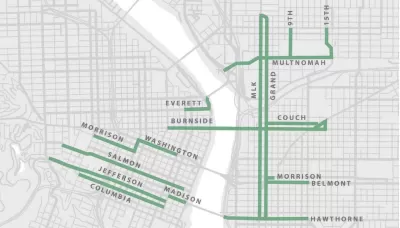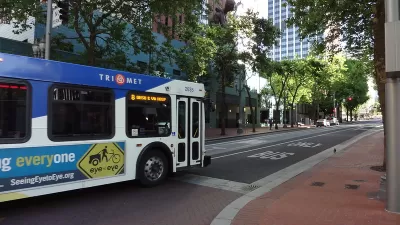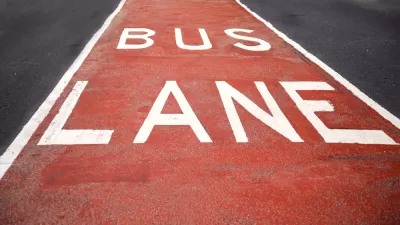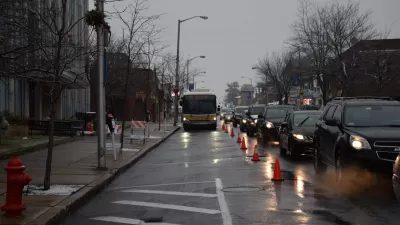Portland will soon be spreading out the red carpet for buses.

"Late last month, the Portland Bureau of Transportation received approval from the Federal Highway Administration to use red coloring on bus-only lanes," reports Jonathan Maus.
Despite their appearance in cities like Seattle and San Francisco, "the use of red to designate bus-only lanes hasn’t been fully adopted into the FHWA’s Manual on Uniform Traffic Control Devices (MUTCD)," explains Maus, necessitating a "request to experiment" before the street treatment can be installed.
Maus also cites Jarrett Walker in explaining the state of the "experiment":
Jarrett Walker, an author and consultant who helps cities improve bus service, says red bus lanes are a no-brainer. “They are an absurdly obvious idea and it’s even more absurd that the federal government had to give us permission,” he shared in an email this morning.
The Portland Bureau of Transportation will use their new red painting powers to implement the Rose Lane Project, funded with $2.5 million from the Bloomberg American Cities Climate Challenge. PDOT still has to finalize the plans for the city's forthcoming bus-only lane network.
"A list of 25 potential bus priority routes were adopted in June 2018 when council passed the Enhanced Transit Corridors (ETC) plan," according to Maus. "That plan identified 15 central city (two of which – SW Madison and NE Everett — have already been implemented) and 10 regional routes that could be turning red (see maps below). 11 of the central city routes are likely to come with a “low-stress” cycling facility."
The city expects to finalize those plans by the end of 2020.
FULL STORY: With key federal approval, Portland is ‘full steam ahead’ on bus lane project

Study: Maui’s Plan to Convert Vacation Rentals to Long-Term Housing Could Cause Nearly $1 Billion Economic Loss
The plan would reduce visitor accommodation by 25,% resulting in 1,900 jobs lost.

Alabama: Trump Terminates Settlements for Black Communities Harmed By Raw Sewage
Trump deemed the landmark civil rights agreement “illegal DEI and environmental justice policy.”

Why Should We Subsidize Public Transportation?
Many public transit agencies face financial stress due to rising costs, declining fare revenue, and declining subsidies. Transit advocates must provide a strong business case for increasing public transit funding.

Paris Bike Boom Leads to Steep Drop in Air Pollution
The French city’s air quality has improved dramatically in the past 20 years, coinciding with a growth in cycling.

Why Housing Costs More to Build in California Than in Texas
Hard costs like labor and materials combined with ‘soft’ costs such as permitting make building in the San Francisco Bay Area almost three times as costly as in Texas cities.

San Diego County Sees a Rise in Urban Coyotes
San Diego County experiences a rise in urban coyotes, as sightings become prevalent throughout its urban neighbourhoods and surrounding areas.
Urban Design for Planners 1: Software Tools
This six-course series explores essential urban design concepts using open source software and equips planners with the tools they need to participate fully in the urban design process.
Planning for Universal Design
Learn the tools for implementing Universal Design in planning regulations.
Smith Gee Studio
Alamo Area Metropolitan Planning Organization
City of Santa Clarita
Institute for Housing and Urban Development Studies (IHS)
City of Grandview
Harvard GSD Executive Education
Toledo-Lucas County Plan Commissions
Salt Lake City
NYU Wagner Graduate School of Public Service





























